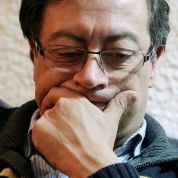by MARION DESCHAMPS
 Left-wing presidential candidate Gustavo Petro.
Left-wing presidential candidate Gustavo Petro.
Colombia’s Ivan Duque – candidate for the far-right party of former President Alvaro Uribe – is in a strong position ahead of the June 17 presidential elections, despite Uribe’s long list of human rights abuses and links with paramilitary groups during his presidency.
Duque’s rival, Gustavo Petro, has an impressive record of social, political and cultural achievements as former mayor of Bogota. He created 417 parks for children; built a dependency of the District University in the suburbs; opened an office dedicated to women and a ‘Citizen LGBTI Center,’ and launched other centers providing legal advice for women seeking to interrupt a pregnancy.
Yet Petro is still struggling to gather the number of votes that would secure victory in the second round of the presidential elections, raising the question: why does the left struggle so much to gain a foothold in Colombia?
Unlike the rest of the continent, Colombia was not forced to live under a military dictatorship during the 1960s and 1970s. Still, the country ranks first in the region in regards to the number of forced disappearances. More than 215,000 people were killed and 5.7 million displaced as a result of the conflict between leftist guerrillas, right-wing paramilitary groups and national security forces.
1. The armed conflict has contributed to the association of left-wing parties with guerrilla violence
Petro’s political enemies have emphasized Petro’s past as a member of former guerrilla group M-19 – born in the 1970s and demobilized in the 1990s – because voters in Colombia tend to conflate guerrilla groups and left-wing political groups.
“Carlos Gaviria, the progressives, Navarro Wolf – these political leaders can say ‘We aren’t FARC, we are social democratic like the European Greens’, but regular citizens don’t see a difference between them and the FARC,” John Fernando Restrepo Tamayo, a professor at the University of Medellin, told Al Jazeera. “People in the cities believe the left parties are emissaries for the guerrillas and the armed struggle.”
Moreover, leftist leaders don’t always make clear their ideological or practical divergences with the guerillas for the sake of public opinion.
“Leftist political parties don’t differentiate themselves in their statements and propaganda from the armed leftist groups,” Carlos Florez Lopez, author of ‘Right and Left in Colombia 1920-1936,’ told Al Jazeera. “This is because some of them believe in the theory of diversity of tactics.”
Por qué no dividimos la política entre derecha e Izquierda? Porque nuestro proyecto es la Democracia. https://t.co/c8jXvm0yZA
— Gustavo Petro (@petrogustavo) January 27, 2018
2. Political and economic elites use the conflict as a way of avoiding having to share power
“Because of the armed conflict, Colombia has been able for years to avoid addressing strong protests or social demands,” said sociologist Daniel Pecaut in an interview with El Tiempo. “The armed conflict has contributed to maintaining the social and political structures of the country, and even to increasing the concentration of land property, as well as the unequal distribution of revenues.”
As a result, he said, Colombia has paradoxically shown consistent economic growth in the past 30 years, yet maintains the same level of social inequality as existed during the 1930s.
TeleSur TV for more
